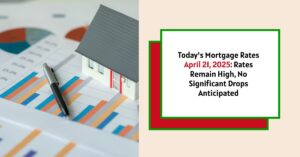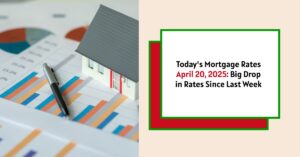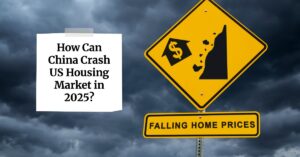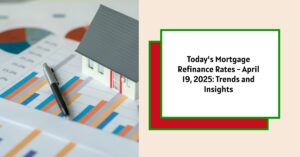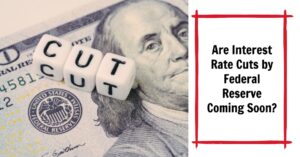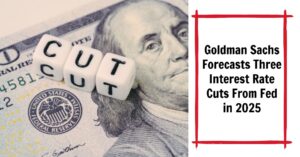Are you glued to the mortgage rates, hoping for some relief? You're not alone. The burning question on everyone's mind is: Will mortgage rates drop below 6% soon? The answer, according to the latest expert analysis, is maybe, but don't hold your breath. While some indicators suggest a potential dip, it's far from a sure thing and likely won't happen overnight. I know it's frustrating, but let's dive into the details and see what's influencing these rates and what the future might hold.
Mortgage Rate Forecast 2025: When Will Rates Go Below 6%?
Mortgage rates have a huge impact on the housing market. High rates make it more expensive to buy a home, squeezing potential buyers and making it harder for current homeowners to refinance. When rates are high, fewer people can afford a home, which can slow down the market and potentially lead to price drops. It's a domino effect that affects everyone from first-time homebuyers to seasoned investors.
I remember when I bought my first house. The difference even a small change in the interest rate made on my monthly payment was significant. It really drove home how much these seemingly small percentages can impact affordability.
The Big Question: When Could Rates Dip Below 6%?
Here's a breakdown of what the experts are saying about the possibility of mortgage rates dropping below 6%:
- Optimistic Outlook: Some experts believe there's a chance rates could fall below 6% this year, especially if inflation continues to cool down and the Federal Reserve starts cutting rates. They emphasize that it won't be a sudden drop, but a gradual process.
- Cautiously Hopeful: Other industry professionals, like Nathan Young of North Star Mortgage Network, are hopeful but realistic. They acknowledge the possibility but stress that it won't happen overnight and depends on various economic factors (CBS News).
- Realistic Expectations: Steve Hill from SBC Lending puts the odds of rates dropping to that level this year at a low 10% to 20%, with a higher probability of 40% to 50% in 2026. This suggests a more prolonged timeline for significant rate decreases.
- Pessimistic View: Some experts, like Adam Neft at GO Mortgage, don't expect rates to drop below 6% anytime soon, citing persistent economic uncertainty and “headwinds” affecting rates.
As you can see, the opinions vary quite a bit! It's a reminder that predicting the future of the market is never an exact science.
What Needs to Happen for Mortgage Rates to Fall?
Several economic factors need to align for mortgage rates to drop below 6%. Here's a look at the key players:
- Declining Inflation: This is the big one. The Federal Reserve wants to see inflation get closer to its 2% target. If inflation eases, the Fed is more likely to lower the federal funds rate, which has a strong influence on mortgage rates.
- Federal Reserve Rate Cuts: The Fed doesn't directly control mortgage rates, but its decisions have a significant impact. They closely watch economic indicators like the Consumer Price Index (CPI) and the Producer Price Index (PPI). Consistent declines in these indices could prompt the Fed to cut rates.
- Stability in the 10-Year Treasury Bond Market: If there's continued uncertainty about the economy, investors might flock to the relative safety of 10-year Treasury bonds. Increased demand for these bonds could drive down their rates, which in turn, could lower mortgage rates.
Think of it like this: Imagine a seesaw. On one side, you have inflation and the Fed's actions. On the other, you have mortgage rates. If inflation goes down and the Fed lowers rates, the seesaw tips in favor of lower mortgage rates. But if inflation stays high or the Fed keeps rates steady, mortgage rates are likely to stay put or even rise.
The Role of the Federal Reserve (The Fed)
I always try to keep a close watch on the Fed and it's very important to understand their role. The Federal Reserve is the central bank of the United States. One of their main jobs is to keep prices stable, which means controlling inflation. They do this by adjusting the federal funds rate, which is the interest rate that banks charge each other for overnight lending.
When the Fed raises the federal funds rate, it becomes more expensive for banks to borrow money. Banks then pass these higher costs on to consumers and businesses in the form of higher interest rates for loans, including mortgages. This can help to cool down the economy and bring inflation under control.
The Impact of Inflation
Inflation is the rate at which the general level of prices for goods and services is rising, and it subsequently reduces the purchasing power. There are mainly two types of inflation: Demand-Pull Inflation: Occurs when there is too much money chasing too few goods. When the economy is booming and people have more money to spend, they tend to buy more. Cost-Push Inflation: Occurs when the prices of production inputs (like wages and materials) increase. This increase in costs is then passed on to consumers in the form of higher prices.
The Federal Reserve aims for an inflation rate of 2%, but is currently above that.
Expert Opinions: A Deeper Dive
Let's break down the expert opinions a bit more to understand where they're coming from:
| Expert | Stance | Reasoning |
|---|---|---|
| Nathan Young | Cautiously Hopeful | Believes rates could drop but emphasizes the need for inflation to ease and the Fed to act. He recognizes the complexity of the market. |
| Matthew Teifke | Optimistic | Sees a real possibility of rates dipping below 6%, citing cooling inflation and potential Fed rate cuts in the latter half of the year. He believes momentum is building. |
| Steve Hill | Realistic | Estimates a low chance of rates dropping this year (10-20%) with better odds in 2026 (40-50%). He notes that rates are coming down slower than anticipated. This highlights the challenge of predicting market movements. |
| Adam Neft | Pessimistic | Doesn't expect rates to fall below 6% soon, citing economic uncertainty and “headwinds”. This underscores the significant challenges the market faces. |
My Personal Take:
Having followed the market closely for years, I lean towards a cautiously optimistic view. I think we might see some downward movement in rates towards the end of the year, but I wouldn't expect a dramatic drop. The Fed is likely to proceed cautiously, and inflation might prove more stubborn than some anticipate. Waiting for the “perfect” rate is a risky game.
What Should You Do?
The best course of action depends on your individual circumstances.
- If you need to buy a home now: Don't try to time the market. Focus on finding a home you can afford at today's rates.
- If you can wait: Keep an eye on the economic indicators and expert forecasts. But remember, the market can change quickly, so don't wait indefinitely.
- Consider your long-term goals: If you're planning to stay in the home for many years, a slightly higher interest rate might not matter as much in the long run.
The Bottom Line
While the prospect of mortgage rates dropping below 6% is appealing, it's not a guarantee. A variety of economic factors will influence the direction of rates, and predictions are mixed. Stay informed, assess your own financial situation, and make a decision that's right for you. Don't get caught up in trying to time the market perfectly. Sometimes, the best time to buy is when you're ready.
Work With Norada, Your Trusted Source for
Real Estate Investment in the U.S.
Investing in turnkey real estate can help you secure consistent returns with fluctuating mortgage rates.
Expand your portfolio confidently, even in a shifting interest rate environment.
Speak with our expert investment counselors (No Obligation):
(800) 611-3060
Also Read:
- Will Mortgage Rates Go Down in 2025: Morgan Stanley's Forecast
- Expect High Mortgage Rates Until 2026: Fannie Mae's 2-Year Forecast
- Mortgage Rate Predictions 2025 from 4 Leading Housing Experts
- Mortgage Rates Forecast for the Next 3 Years: 2025 to 2027
- 30-Year Mortgage Rate Forecast for the Next 5 Years
- 15-Year Mortgage Rate Forecast for the Next 5 Years
- Why Are Mortgage Rates Going Up in 2025: Will Rates Drop?
- Why Are Mortgage Rates So High and Predictions for 2025
- Will Mortgage Rates Ever Be 3% Again in the Future?
- Mortgage Rates Predictions for Next 2 Years
- Mortgage Rate Predictions for Next 5 Years
- Mortgage Rate Predictions: Why 2% and 3% Rates are Out of Reach
- How Lower Mortgage Rates Can Save You Thousands?
- How to Get a Low Mortgage Interest Rate?
- Will Mortgage Rates Ever Be 4% Again?



